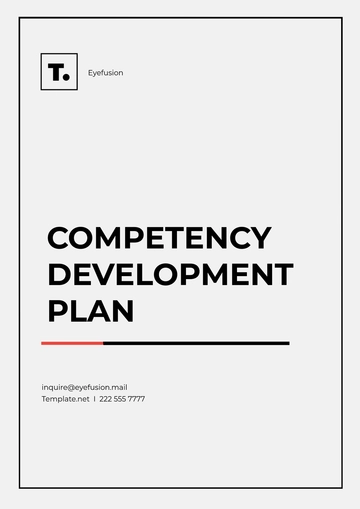Strategic Business Development Plan
Prepared by: | [YOUR NAME] |
|---|
Company: | [YOUR COMPANY NAME] |
|---|
Department: | [YOUR DEPARTMENT] |
|---|
Date: | [DATE] |
|---|
I. Executive Summary
[YOUR COMPANY NAME] presents its strategic vision to achieve sustainable growth through market expansion and product innovation. The plan outlines key objectives and initiatives to drive revenue growth and enhance market competitiveness.
II. Company Analysis
A. Mission and Vision Statement
B. Core Values
Customer-centricity
Innovation
Integrity
Collaboration
C. SWOT Analysis
Strengths | Weaknesses | Opportunities | Threats |
|---|
Strong brand reputation | Limited market penetration | Emerging markets | Intense competition |
Robust product portfolio | Dependence on key suppliers | Strategic partnerships | Economic downturns |
Experienced management team | High operational costs | Technological advancements | Regulatory changes |
III. Market Analysis
A. Target Market
Our target market includes small to medium-sized enterprises (SMEs) in the technology, healthcare, and finance sectors.
B. Industry Trends
Increasing demand for cloud-based solutions
Growing importance of cybersecurity
Shift towards subscription-based services
C. Competitor Analysis
Competitor | Strengths | Weaknesses | Market Position |
|---|
[COMPETITOR 1] | Strong brand presence | Limited product range | Market leader in the healthcare sector |
[COMPETITOR 2] | Innovative solutions | Lack of global presence | Strong foothold in the finance industry |
[COMPETITOR 3] | Cost-effective pricing | Limited scalability | Emerging player in the technology sector |
IV. Strategic Goals and Objectives
A. Long-term Goals
Achieve 20% year-over-year revenue growth.
Expand market reach to target new geographic regions.
B. Short-term Objectives
Increase customer retention rate by 15% within the next 12 months.
Launch two new product lines by the end of the fiscal year.
C. Key Performance Indicators (KPIs)
V. Strategic Initiatives
A. Market Expansion Strategies
B. Product Development Strategies
C. Sales and Marketing Strategies
D. Partnership and Collaboration Strategies
VI. Financial Plan
A. Revenue Projections
Year | Projected Revenue (USD) |
|---|
2065 | $5,000,000 |
2066 | $6,000,000 |
2067 | $7,200,000 |
B. Budget Allocation
Expense Category | Allocation (%) |
|---|
Marketing | 30 |
R&D | 20 |
Sales | 25 |
Operations | 15 |
Miscellaneous | 10 |
C. Investment Plans
VII. Implementation Plan
A. Timeline
Q1: Conduct market research and analysis.
Q2: Develop and finalize strategic plan.
Q3: Begin implementation of marketing and sales initiatives.
Q4: Monitor progress and make adjustments as necessary.
B. Responsible Parties
CEO: Overall strategic direction and decision-making.
CMO: Marketing strategy and execution.
CFO: Financial planning and budget management.
C. Resource Allocation
Allocate human, financial, and technological resources as needed to support strategic initiatives.
VIII. Monitoring and Evaluation
A. Regular Review Process
B. Performance Tracking
C. Adjustment Strategies
IX. Risk Management Plan
A. Identification of Potential Risks
Market fluctuations
Regulatory changes
Cybersecurity threats
B. Mitigation Strategies
Diversification of revenue streams
Compliance with industry regulations
Implementation of robust cybersecurity measures
C. Contingency Plans
X. Conclusion
In conclusion, the Strategic Business Development Plan outlines our roadmap for achieving sustainable growth and maintaining our competitive edge in the marketplace. By focusing on market expansion, product innovation, and strategic partnerships, we aim to capitalize on emerging opportunities and overcome potential challenges.
Plan Templates @ Template.net






























